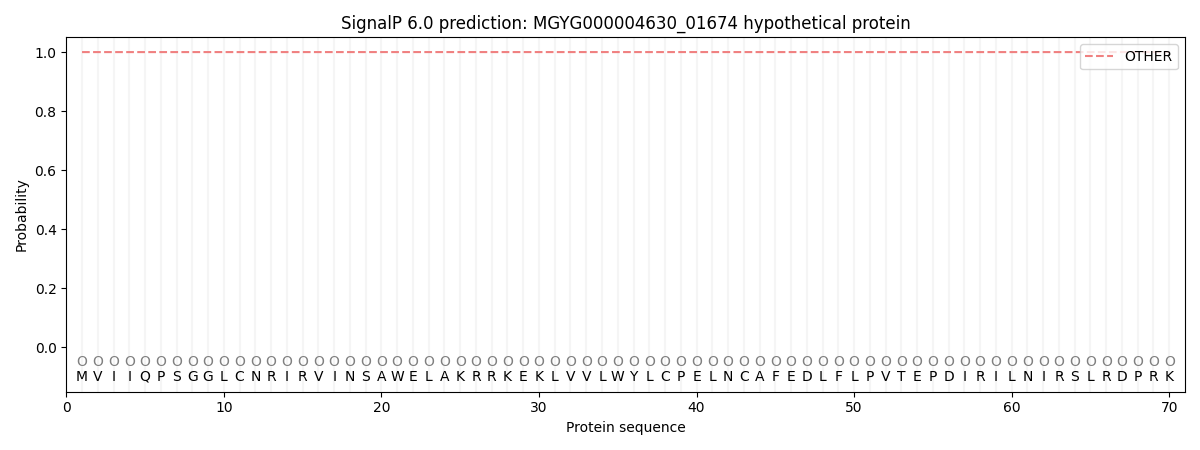You are browsing environment: HUMAN GUT
CAZyme Information: MGYG000004630_01674
You are here: Home > Sequence: MGYG000004630_01674
Basic Information |
Genomic context |
Full Sequence |
Enzyme annotations |
CAZy signature domains |
CDD domains |
CAZyme hits |
PDB hits |
Swiss-Prot hits |
SignalP and Lipop annotations |
TMHMM annotations
Basic Information help
| Species | ||||||||||||
|---|---|---|---|---|---|---|---|---|---|---|---|---|
| Lineage | Bacteria; Firmicutes_A; Clostridia; Lachnospirales; Lachnospiraceae; Anaerosacchariphilus; | |||||||||||
| CAZyme ID | MGYG000004630_01674 | |||||||||||
| CAZy Family | GT23 | |||||||||||
| CAZyme Description | hypothetical protein | |||||||||||
| CAZyme Property |
|
|||||||||||
| Genome Property |
|
|||||||||||
| Gene Location | Start: 445; End: 1236 Strand: + | |||||||||||
CAZyme Signature Domains help
| Family | Start | End | Evalue | family coverage |
|---|---|---|---|---|
| GT23 | 5 | 250 | 8.5e-22 | 0.8333333333333334 |
CDD Domains download full data without filtering help
| Cdd ID | Domain | E-Value | qStart | qEnd | sStart | sEnd | Domain Description |
|---|---|---|---|---|---|---|---|
| cd11548 | NodZ_like | 6.38e-40 | 1 | 256 | 1 | 285 | Alpha 1,6-fucosyltransferase similar to Bradyrhizobium NodZ. Bradyrhizobium NodZ is an alpha 1,6-fucosyltransferase involved in the biosynthesis of the nodulation factor, a lipo-chitooligosaccharide formed by three-to-six beta-1,4-linked N-acetyl-d-glucosamine (GlcNAc) residues and a fatty acid acyl group attached to the nitrogen atom at the non-reducing end. NodZ transfers L-fucose from the GDP-beta-L-fucose donor to the reducing residue of the chitin oligosaccharide backbone, before the attachment of a fatty acid group. O-fucosyltransferase-like proteins are GDP-fucose dependent enzymes with similarities to the family 1 glycosyltransferases (GT1). They are soluble ER proteins that may be proteolytically cleaved from a membrane-associated preprotein, and are involved in the O-fucosylation of protein substrates, the core fucosylation of growth factor receptors, and other processes. |
| cd11296 | O-FucT_like | 1.54e-12 | 105 | 252 | 29 | 201 | GDP-fucose protein O-fucosyltransferase and related proteins. O-fucosyltransferase-like proteins are GDP-fucose dependent enzymes with similarities to the family 1 glycosyltransferases (GT1). They are soluble ER proteins that may be proteolytically cleaved from a membrane-associated preprotein, and are involved in the O-fucosylation of protein substrates, the core fucosylation of growth factor receptors, and other processes. |
| cd11300 | Fut8_like | 1.14e-08 | 126 | 238 | 165 | 294 | Alpha 1-6-fucosyltransferase. Alpha 1,6-fucosyltransferase (Fut8) transfers a fucose moiety from GDP-fucose to the reducing terminal N-acetylglucosamine of the core structure of Asn-linked oligosaccharides, in a process termed core fucosylation. Core fucosylation is essential for the function of growth factor receptors. O-fucosyltransferase-like proteins are GDP-fucose dependent enzymes with similarities to the family 1 glycosyltransferases (GT1). They are soluble ER proteins that may be proteolytically cleaved from a membrane-associated preprotein, and are involved in the O-fucosylation of protein substrates, the core fucosylation of growth factor receptors, and other processes. |
| cd11301 | Fut1_Fut2_like | 3.75e-07 | 1 | 244 | 1 | 233 | Alpha-1,2-fucosyltransferase. Alpha-1,2-fucosyltransferases (Fut1, Fut2) catalyze the transfer of alpha-L-fucose to the terminal beta-D-galactose residue of glycoconjugates via an alpha-1,2-linkage, generating carbohydrate structures that exhibit H-antigenicity for blood-group carbohydrates. These structures also act as ligands for morphogenesis, the adhesion of microbes, and metastasizing cancer cells. Fut1 is responsible for producing the H antigen on red blood cells. Fut2 is expressed in epithelia of secretory tissues, and individuals termed "secretors" have at least one functional copy of the gene; they secrete H antigen which is further processed into A and/or B antigens depending on the ABO genotype. O-fucosyltransferase-like proteins are GDP-fucose dependent enzymes with similarities to the family 1 glycosyltransferases (GT1). They are soluble ER proteins that may be proteolytically cleaved from a membrane-associated preprotein, and are involved in the O-fucosylation of protein substrates, the core fucosylation of growth factor receptors, and other processes. |
| cd11302 | O-FucT-1 | 0.006 | 142 | 245 | 232 | 327 | GDP-fucose protein O-fucosyltransferase 1. The protein O-fucosyltransferase 1 (Ofut1 or O-FucT-1) adds O-fucose to EGF (epidermal growth factor-like) repeats. The O-fucsosylation of the Notch receptor signaling protein is dependent on this enzyme, which requires GDP-fucose as a substrate. O-fucose residues added to the target of O-FucT-1 may be further elongated by other glycosyltransferases. On top of O-fucosylation, O-FucT-1 may have other functions such as the regulation of the Notch receptor exit from the ER. Six highly conserved cysteines are present in O-FucT-1, which is a soluble ER protein, as well as a DXD-like motif (ERD), conserved in mammals, Drosophila, and C. elegans. Both features are characteristic of several glycosyltransferase families. The membrane-bound pre-protein is released by proteolysis and, as for most glycosyltransferases, is strongly activated by manganese. O-FucT-1 is similar to family 1 glycosyltransferases (GT1). |
CAZyme Hits help
| Hit ID | E-Value | Query Start | Query End | Hit Start | Hit End |
|---|---|---|---|---|---|
| QUO20668.1 | 1.33e-107 | 1 | 261 | 1 | 260 |
| AFY93872.1 | 1.00e-48 | 1 | 263 | 9 | 290 |
| AWI06383.1 | 4.80e-46 | 1 | 249 | 1 | 251 |
| QNT65604.1 | 5.62e-34 | 2 | 255 | 3 | 262 |
| AFM05932.1 | 1.05e-31 | 2 | 258 | 5 | 301 |
Swiss-Prot Hits help
SignalP and Lipop Annotations help
This protein is predicted as OTHER

| Other | SP_Sec_SPI | LIPO_Sec_SPII | TAT_Tat_SPI | TATLIP_Sec_SPII | PILIN_Sec_SPIII |
|---|---|---|---|---|---|
| 1.000065 | 0.000000 | 0.000000 | 0.000000 | 0.000000 | 0.000000 |
